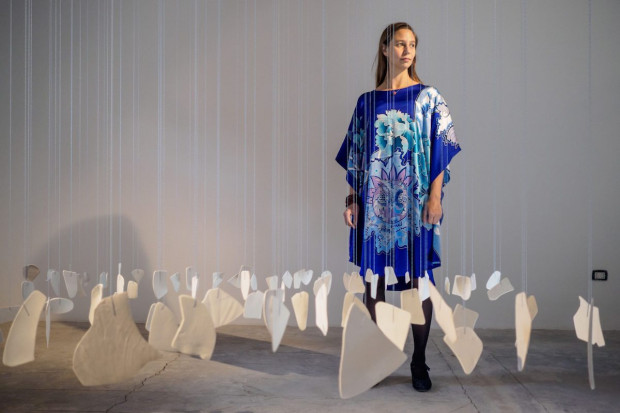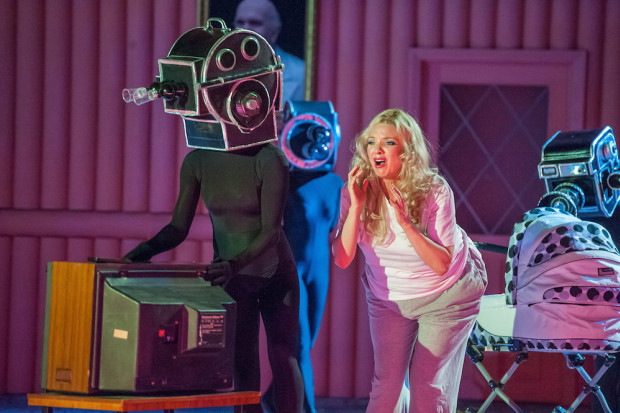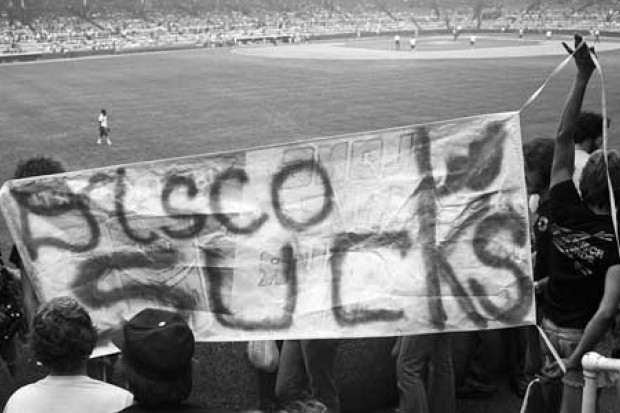
Soft Bombs and Stories: Oren Ambarchi
Over the past decade, iconoclastic Australian guitarist Oren Ambarchi has been honing his inimitable soundworld throughout a remarkable series of solo recordings, from Persona and Suspension from around the beginning of the new century and 2004’s Grapes from the Estate to the recent In the Pendulum’s Embrace. One of the things that makes Ambarchi’s music so distinct, that allows the listener to keep returning to it, is the fact that despite some superficial similarities with minimalism and electronica, it is underpinned – especially the work from the past five years or so – by Ambarchi’s desire, regardless of the level of abstraction, to tell stories. As he said in an interview in White Heat magazine in 2007, ‘I like the music to have some sort of narrative’, and this is why the more recent, lengthy pieces unfold the way they do, each describing an organic course, replete with shifts in mood and changes of direction, gathering and shedding various elements along the way. Another relevant detail is that whatever music he listens to himself, Ambarchi says he is always looking to ‘be moved’, and the corollary of that is that he also wants his listeners to be moved. This combination of some level of narrative strategy allied with emotional intent sets him apart from many practitioners of the genres I mention above, who are usually more interested in process and states of being than eliciting emotional responses.
Although he is a guitarist, Ambarchi’s approach to the instrument – the electric guitar, mainly – is definitely non-idiomatic; there is a remarkable lack of history to his sound, no echoes of rock or pop let alone of any Spanish or acoustic avatars. When he plays there is usually an array of devices between the guitar pick-up and the final sound, creating a dislocation between what one knows is taking place to produce the music and what one is hearing. In an interview by email he told me:
It’s all guitar and basic effects pedals, nothing too fancy. I never use a computer to process sounds (before or after). A lot of my sounds are made from the pedals doing things they are not supposed to do, or consciously making the pedal malfunction to an extent and working with that material.
Ambarchi’s work defies easy categorisation – it’s perhaps simpler to describe it on its own terms than to try and create connections with various movements or genres which may be more accidental than real. For instance, the sound he produces sometimes has the surface sheen of electronica and yet because the generation of the sound is directly physical, from fingers on strings rather than fingers on keys, there is quite a distinct feeling of ebb and flow, of contrasts in timbre and dynamic and even of pitching that you simply don’t get in, for instance, techno music. There is also a very strong element of repetition, of a kind which seems akin to certain ambient musics but actually more organic and evolutionary than one would normally find there. Ambarchi himself has said that a lot of what he does is ‘really connected to rock music’ (Sydney Morning Herald, 19 January 2008), but in a very reductive way, as if stripped to the bones.
Another striking aspect of Ambarchi’s music, and the one which helps to create that mental divorce between cause and effect so strongly, is the fact that the sounds are so rounded, lacking the usual attack that a plucked guitar string has. Obviously this is due to the effects he uses, but the feeling still remains, especially in the earlier albums, that sounds are being turned on and off rather than being created and then let decay. Among these sounds, however, there is a great deal of differentiation once one acclimatises, as it were. What pianist John Tilbury once wrote about Feldman’s music on the liner notes to For Bunita Marcus is equally applicable here: ‘Only when one has become accustomed to the dimness of light can one begin to perceive the richness and variety of colour which is the material of the music.’
It is easy enough to hear the same musician’s voice across Ambarchi’s older and newer recordings; what has evolved, though, is a more considered use of musical space, a more sophisticated approach to harmony and even – finally – the occasional occurrence of untreated, ‘real’ guitar sounds as a new and welcome colour.
The tracks on the early studio album Suspension (2001) are all quite short, around six or seven minutes each (those on Persona (2001), recently re-released, can be much longer). The separate pieces all have a sense of immediate completeness about them, like sculptures one can look at from different angles (something which cannot be said about the more recent music). Each has a definite pulse and a density of sound which makes it an intense listening experience despite its brevity – like opening a door into a room where one immediately comprehends the nature of the separate elements contributing to the overall decor; the duration is almost incidental. The opening track for instance, ‘Wednesday’, sounds massive, as if made in a shipyard: the limited but arresting layers reverberate heavily, framed by a metric regularity also present in the fourth track, ‘gene’, which gives an embryonic idea of what will follow a few years later, with the first appearance of the slowly rhythmic, velvet-wrapped detonations of sound which form the core of the next solo release. A slightly earlier album, Insulation (1999), has a more experimental character which gives few clues as to Ambarchi’s soon-to-be-embarked-on trajectory, and so I won’t discuss it here.
The evolution which took place in the three years between Suspension and Grapes from the Estate (2004) is remarkable. The latter album contains just four tracks, each between ten and twenty minutes in length. Ambarchi has said that a lot of the music he creates is ‘actually derived from the process of elimination’ (Sydney Morning Herald) and in Grapes the density of sound is now lower, the sense of rhythm much more abstract – there is a certain regularity to many aspects of the music, but, like an old pulsar, events unfold over much greater spans of time. There is also a strong feeling of completeness about the whole album, the way each track follows on from the last, how the experience of listening to the entire album at once is more satisfying than listening to specific tracks on their own. In a way, it’s as if Ambarchi has adopted a back-to-basics approach, although the opposite is more likely true.
Since these pieces are obviously an evolutionary step forward from those on the previous album I was curious about the amount of compositional pre-planning Ambarchi might or might not use in creating such large structures:
I try and approach the first take of a recording without too much thought so there’s scope for potential development. The first take is usually a really simple idea to begin with and I usually develop this initial take by juxtaposing it with other ideas/overdubs that might not necessarily ‘work’ (I get excited by happy accidents). So apart from keeping it simple, there’s no formal outline to begin with.
Somehow I wasn’t too surprised at this answer, as the later works do have a sense of gradual unfolding which in hindsight can be connected to the approach Ambarchi describes. Nonetheless, years of experience as a performer and composer go into this, and, if anything, it’s designed to let his personality through even more clearly than a heavily pre-composed approach. Take ‘Corkscrew’, for example, the first piece on Grapes from the Estate: it presents very simple elements, Ambarchi’s trademark rounded sounds, the ‘soft bombs’ of this article’s title revolving around three pitches in a tonic-subdominant-dominant relationship, as if he’s saying, ‘This is where I’m starting, isn’t it beautiful? Now see what I can do with it.’ In the succeeding track, ‘Girl With the Silver Eyes’, Ambarchi enlarges the sound pool by introducing an almost-real guitar sound, still modified enough to sound more like a dulcimer, but you can identify the source clearly. More layers are added, subtly, patiently, even a Hammond organ eventually makes an appearance. Each layer is also slightly out of tune with the others – only by a few cents, but enough to give added delineation to the various strata. The presence of very gentle percussion is in this context a novel, but instantly beguiling element, played by Ambarchi himself, who studied drums in Sydney as a teenager.
Then comes the clincher, ‘Remedios the Beauty’, surely Ambarchi’s loveliest creation. It opens rhythmically, though gently, as if a laid-back African tribal dance had somehow gotten tangled up in a circuit board. As this track progresses, one gradually becomes aware of just how sophisticated this music is. Tonally clear yet ambitious, its sense of metre occasionally changes gear throughout its fifteen-minute span, and sometimes through subtraction rather than addition of layers, which impresses that part of my brain which likes to pay attention to such things: just when you get used to thinking in four, or five, suddenly a layer drops out and your brain has to quickly readjust to what now feels like a triple metre. Musically, though, the piece is incredibly attractive – bells appear, little ones which describe a small-stepped melody, supported by swooning strings (just two instruments, enough to add a strong hue); gently shuffling drums add another distinct colour, fleshed out towards the end by a piano supporting the main shifts of melody and harmony. It’s such a wonderful construction that I’m always a little sad when it ends. Ambarchi makes sure that emotion is underpinned by finishing with ‘Stars Aligned, Webs Spun’, a funereal piece, the longest on the album, which, while built upon a regularly-tolling bell hoisted over a bed of subtones, again has that wonderful sense of evolution which involves a gradual adornment with higher-tessitura chords and more of those soft bombs, exploding quietly off-pitch, way down in the depths.
It’s one thing to have an inkling of the mechanics behind the making of the music, but is there some fundamental inspiration for it all? Perhaps Ambarchi’s youthful studies of Jewish mysticism might have an influence on how he approaches his music:
There may be a connection to the music I make and the rituals I experienced when I was younger in Synagogue which involved slowly chanting and repeating the same sentences and melodies over and over again. I guess a lot of what interests me is losing yourself in the sound and also the idea of a ‘search’ within a lengthy piece of music (I’ve always loved Indian ragas, which relates to this) – starting something in a simple manner and then ‘exploring’ it over an extended period. Sometimes things only ‘come together’ (or the intention is revealed) right at the end of a piece. I do like utilising sounds that are quite physical and using that material to transport the listener – there might be a relation to this and the esoteric teachings in Judaism of elevating the mundane or physical and transforming it into something spiritual.
It would be remiss of me not to mention Ambarchi’s many collaborative projects, two of which began to bear real fruit around the time of Grapes. One half of the American drone metal duo Sunn O))), Stephen O’Malley, played a track by Ambarchi at a DJ-ing session a few years back and, the story goes, the frequencies in Ambarchi’s piece were so strong, and the volume so loud, that the fire alarms were set off and the building had to be evacuated. The next morning Ambarchi got a phone call from O’Malley saying, ‘Oren, we need to work together’, and so Ambarchi has become an occasional member of Sunn O))), playing on their last couple of albums and occasionally touring with the band. This seems to have influenced his solo work to a degree, those incredibly loud and low distorted chords so typical of the drone metallers’ sound morphing into a much gentler but still obviously related strand in Ambarchi’s sonic weave. In fact, Ambarchi acknowledges the influence directly, saying his sound on the recent solo albums is ‘much more physical’ (Wire, September 2007) because of his work with the Americans.
Another salient relationship is with his producer Chris Townend, with whom he formed the duo Sun (not to be confused with the drone metal band). Sun released their second album, I’ll Be the Same, in 2007, the same year as Ambarchi released In the Pendulum’s Embrace. The two could not, on the surface, be more different – Sun’s album is a very lo-fi, guile-less excursion into almost-pop (but innocently endearing nonetheless), employing stripped-back instrumentation and naïve yet attractive melodies.
In the Pendulum’s Embrace, on the other hand, is a continued exploration of the dark side. Yet there can be no doubt that a more melodic element in the solo album hasn’t just appeared by accident – Ambarchi even sings at one point and by the end of the last track, ‘Trailing Moss in Mystic Glow’, we are left with pure acoustic guitar, devoid of any electronic elaboration, just accompanied by a faint layer of watery musique concrète. The album’s title refers to Ambarchi’s fondness for trance-inducing sounds:
I love music that puts the listener in a hypnotic state… The image of a pendulum swinging back and forth is attractive to me, it’s so simple yet there’s a hidden complexity in its mechanics and watching it can be mesmerising. (Wire)
Right from the off in Pendulum there’s clearly a much greater willingness to mix and match the natural and the artificial – the on/off heavily modified sounds are still there, but now also present are plainly-played and unadorned electric and acoustic guitars, as well as clearly acoustic cymbal brushwork. Rather than jarring, these two worlds complement each other incredibly well, as if they were just waiting to be brought together. So in that sense, while Pendulum is very much in the territory of Grapes regarding the actual musical material and track length, it’s a step forward in terms of sonic exploration, and all the more attractive for that. The opening track, ‘Fever, A Warm Poison’, is the most spacious piece Ambarchi has so far committed to posterity – the material is so minimal, the sounds so relaxed, and yet it’s completely absorbing. It’s certainly a testament to his talent and puts me in mind of Feldman’s dictum about letting sounds be themselves. Ambarchi does that here more than anywhere else before, obviously believing there’s enough import and inherent attractiveness in each tone to not have to rush headlong into the next.
Ambarchi’s trajectory has always been shaped by his desire to keep moving (nicely in opposition to Sun’s second album title, I’ll Be the Same) and in that process he has found himself navigating some out-of-the-way places musically.
I’m thinking of approaching my next solo record a little differently and not starting with the guitar as I always have done in the past. I’m thinking of starting with other instruments (such as percussion) and building/fleshing it out with guitar after that. We’ll see if it works but I’m hoping it’ll push me into newer areas.
It is perhaps tempting to draw parallels between the vast, unpopulated tracts of land that abound in Ambarchi’s home country and the spaciousness of his recent music, but whatever the correlations it’s exciting to know that his thirst for discovery is undiminished.
Published on 1 December 2009
Ian Wilson is a composer















